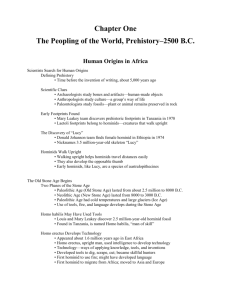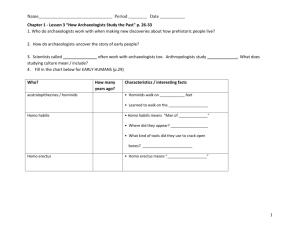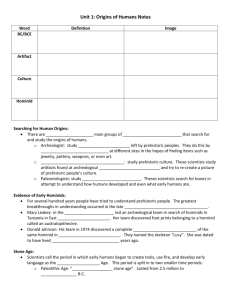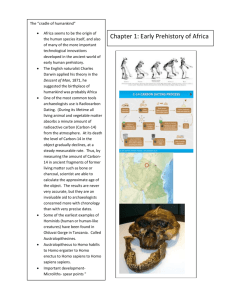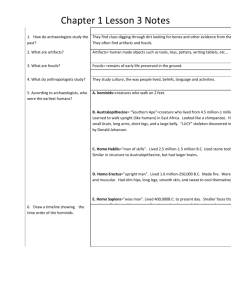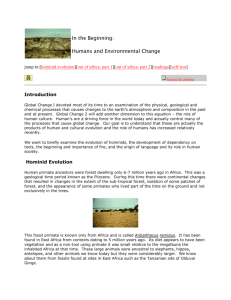Early humans Worksheet - Mr. Knutson`s History
advertisement
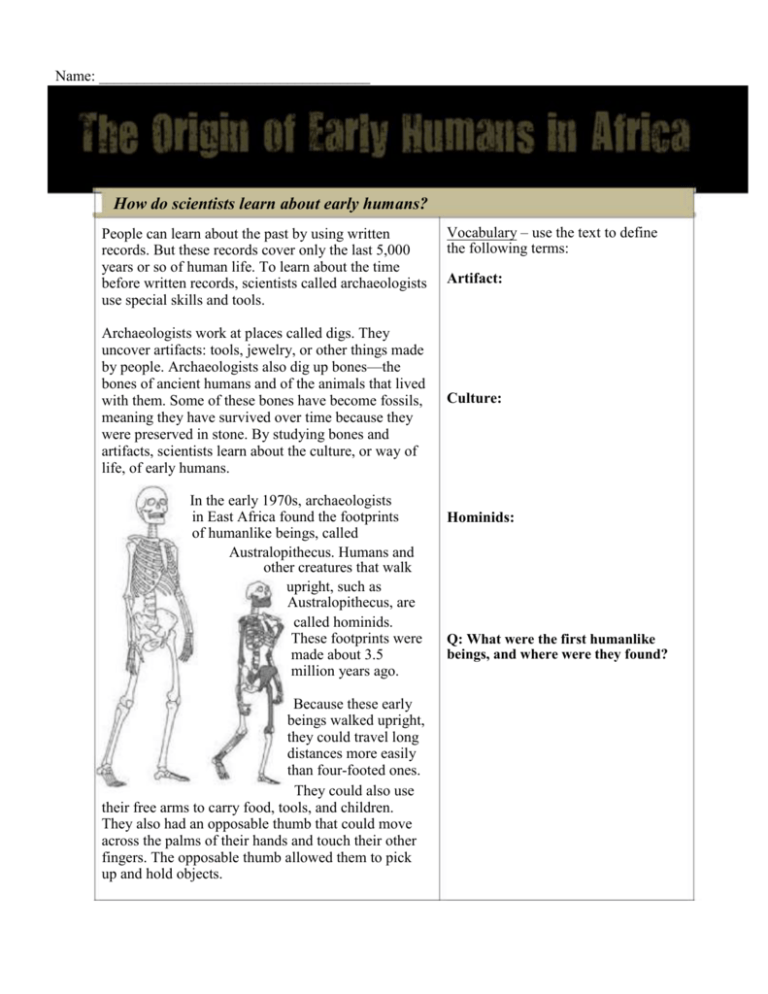
Name: ____________________________________ How do scientists learn about early humans? People can learn about the past by using written records. But these records cover only the last 5,000 years or so of human life. To learn about the time before written records, scientists called archaeologists use special skills and tools. Archaeologists work at places called digs. They uncover artifacts: tools, jewelry, or other things made by people. Archaeologists also dig up bones—the bones of ancient humans and of the animals that lived with them. Some of these bones have become fossils, meaning they have survived over time because they were preserved in stone. By studying bones and artifacts, scientists learn about the culture, or way of life, of early humans. In the early 1970s, archaeologists in East Africa found the footprints of humanlike beings, called Australopithecus. Humans and other creatures that walk upright, such as Australopithecus, are called hominids. These footprints were made about 3.5 million years ago. Because these early beings walked upright, they could travel long distances more easily than four-footed ones. They could also use their free arms to carry food, tools, and children. They also had an opposable thumb that could move across the palms of their hands and touch their other fingers. The opposable thumb allowed them to pick up and hold objects. Vocabulary – use the text to define the following terms: Artifact: Culture: Hominids: Q: What were the first humanlike beings, and where were they found? What advances did hominids make during the Stone Age? Humans made important advances during a period called the Stone Age, when people used tools made of stone. At this time, they also began to use fire and learned to speak. Vocabulary Paleolithic Age: Scientists divide the Stone Age into two parts. The Paleolithic Age, or Old Stone Age, began about 2.5 million years ago and lasted until about 8000 B.C. The Neolithic Age, or New Stone Age, went from about 8000 B.C. to around 3000 B.C. Neolithic Age: Much of the Old Stone Age overlapped the Ice Age, when the earth was colder than it is now. Huge sheets of ice—glaciers— covered much of the land. About 10,000 years ago, the earth’s temperature increased. The ice sheets grew smaller. People began to roam wider stretches of land. Technology: In East Africa, archaeologists found a hominid fossil they named Homo habilis. It means “man of skill.” The fossil was given this name because the site also held tools made of lava rock. Homo habilis lived about 2.5 million years ago. About 1.6 million years ago, another kind of hominid lived. This one was Homo erectus. Homo erectus began to use tools for special purposes. That is when technology began. Homo erectus dug for food in the ground, cut meat from animal bones, and scraped animal skins. Homo erectus also used fire and may have had spoken language. Q: Who were Homo habilis and Homo erectus? Timeline: Fill in the timeline with the 3 correct dates ├──────────────────────────────────────┼─────────────┤ Paleolithic Age begins Paleolithic Age ends Neolithic Age begins Neolithic Age ends Who were the Neanderthals and Cro-Magnons? Many scientists believe that Homo erectus eventually developed into humans, or Homo sapiens. Vocabulary Homo sapiens: Scientists once thought that Neanderthals were ancestors of modern humans but no longer do. These hominids appeared 200,000 years ago. They lived in caves or built shelters of wood or animal skins. At one time, they were thought to be rough and wild people. Now scientists think that they may have held religious beliefs. These people found ways to survive the freezing cold of the Ice Age. About 30,000 years ago, though, the Neanderthals strangely disappeared. About 10,000 years before these people vanished, the CroMagnons appeared. Their bodies were just like those of modern people. Scientists think that these people worked with one another in planning large-scale hunts of animals. They may have also had more skill at speaking than did the Neanderthals. Because they had these skills, the CroMagnons were better at finding food. That may explain why Cro-Magnons survived and Neanderthals did not. Q: How is the species Homo sapiens different from earlier hominids? Scientists are continuing to work on many sites in Africa. New discoveries continually add to what we know about human origins. Matching: match the hominid species with the associated physical trait and achievement Hominid Species Physical Trait and Achievement ____ Built shelters of wood and skin 1. Australopithecines ____ Used Complex language ____ Developed religious beliefs 2. Homo habilis ____ First to use fire 3. Homo erectus ____ First to use spoken language! ____ First to walk upright 4. Neanderthals ____ First toolmaker ____ Physically identical to us! 5. Cro-Magnons ____ First to have opposable thumb ____ Planned complicated hunts ____ First to use technology

